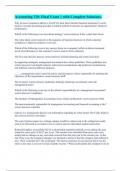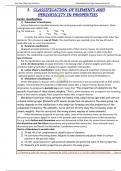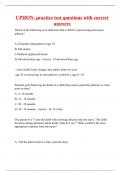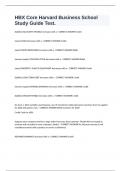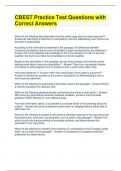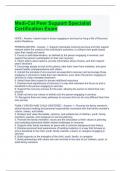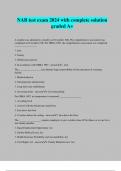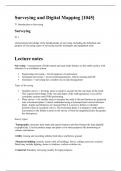Chapter 1: Limits, Alternatives and Choices
The definition of economics
Economics: The study of how individuals, businesses and institutions make social choices, to optimize their
level of satisfaction under conditions of scarcity.
The Economic Perspective
Ø Scarcity and Choice
- Limited goods and services
- Limited time
Ø Opportunity Cost
- The value of the next best alternative that must be forgone in order to undertake the activity.
Ø Rational (purposeful) behavior
- ‘Rational self-interest’ an assumption of economics
- Decisions not free from mistakes or unaffected by emotions or feelings
- Desire to maximize level of satisfaction (utility)
o Utility (U): Utility is the pleasure, happiness or satisfaction obtained from consuming a good or
service.
§ Concepts of utility
- Cardinal (measureable) vs. ordinal (comparative)
- Choose between options to max U
- Allocation of time, energy and money
Ø Rational Consumers
- This is the essence of optimal behavior and it consists of three elements namely, calculations,
negotiation and expenditure
- The greatest possible U with unlimited wants/needs and certain budget constraints
Ø Rational Producers
- Maximize profits with cost constraints and certain production techniques
Ø Marginal Analysis: Benefits and Costs
- The comparison of marginal benefits and marginal costs, usually for decision making
- Marginal = “extra”, “additional” or “change in”
- Marginal costs and benefits
- Decision to obtain the marginal benefit associated with some specific option always includes the
marginal cost of forgoing something else (i.e. opportunity costs present!)
Theories, Principles and Models
- Theories, principles and models are ‘rational simplifications’
- Economic principles: Highly useful for analyzing economic behavior and understanding how the economy
works
,Jasmine van der Nat University of Pretoria EKN 110
Ø Scientific methods
- Form and test hypotheses of cause-and-effect relationships to generate theories, laws and principles
Ø Economic principles and models
- Tools for ascertaining cause and effect
• Generalizations: Tendencies of typical or average consumers, workers or business firms.
• Other-things-equal-assumption (ceteris paribus): A strong assumption for a particular analysis
where all variables are held constant for a particular analysis except those under immediate
consideration (i.e. price-quantity demanded)
• Graphical expression: Many economic models are expressed graphically.
Microeconomics and Macroeconomics
Macroeconomics: It examines either the economy as a whole or its basic subdivisions or aggregates
(government, households and business sectors).
- An aggregate is a collection of specific economic units treated as if they were one unit.
- Aggregates seek to obtain general outlines or an overview of the structure of economy and the
relationships of its major aggregates.
Microeconomics: It is concerned with individual units such as a person, a household, a firm or an industry.
- At this level the economists observe the details of an economic unit or very small segment of the
economy under a figurative microscope.
Positive and Normative Economics
Positive economics: It focuses on facts and cause and effect relationships. It includes description, theory
development and theory testing. This avoids value judgments and tries to establish scientific statements.
- Deals with hat the economy actually likes
- Concerns ‘what is’
Normative economics: It incorporates value judgments about what the economy should be like or what
particular policy actions should be recommended to achieve a desirable goal. It provides expressions of
support for particular policies
- Concerns ‘what should be’
An Individual’s Economizing Problem
Economizing problem: The need to make small choices because economic wants exceed economic means.
Microeconomic model of the economizing problem:
Ø Limited Income and Unlimited Wants
- The desire for goods and services that provide utility are high
- Necessities vs. luxuries
- Limited income and insatiable wants cause us to choose goods and services that create maximum
utility
Ø The budget Line
- It is a schedule or curve that shows various combinations of two products a producer can purchase
with a specific money income
- The budget line shows the economizing problem graphically
,Jasmine van der Nat University of Pretoria EKN 110
• Attainable and unattainable combinations
- Points that show whether the consumer can buy or not the specific
combination of products
• Trade-offs: A sacrifice quantity of one for another. Opportunity cost: associated
with each choice
• Choice
- Limited income forces people to choose what they want to buy in order to
fulfill their wants
- They evaluate marginal benefits and marginal costs to make choices that
maximize your satisfaction
• Income changes
- An increase in money income shifts the budget line to the right (vice versa)
Society’s Economizing Problem
Ø Scarce Resources
Ø Resource Categories (Factors of Production or Inputs)
- Land: Natural resources used in production process, such as arable land, forests, mineral and oil
deposits and water resources
- Labour: Physical and mental talents of individuals used in producing goods or services
- Capital: Manufactured aids used in producing consumer goods and services (factory, storage,
transportation and distribution facilities, tools and machinery). The purchase of capital goods is an
investment.
- Entrepreneurial ability: The entrepreneur takes the initiative of combining the resources of land,
labour and capital to produce goods and services. The entrepreneur makes a strategic business
decision that sets the course of the business. The entrepreneur is an innovator. The entrepreneur
bears risks.
Production Possibilities Model
The main assumptions:
• Full employment: The economy is employing all its available resources.
• Fixed resources: The quantity and quality of the factors of production are fixed.
• Fixed technology: The state of technology is constant.
• Two goods: The economy is producing only two goods (consumer goods and capital goods).
Ø Production Possibilities Model
- This lists the different combinations of two products that can be produced with a specific set of
resources, assuming full employment.
Ø Production Possibilities Curve (PPC)
- Each point on the curve represents the maximum output of two products
- The curve is a ‘constraint’ because it shows the limit of attainable outputs
- The optimal point on the production curve represents the most desirable mix of goods and is
determined by expanding the production of each good until its marginal benefit equals its marginal
cost
Ø Law of Increasing Opportunity Cost
- As the production of particular good or service increases, the opportunity cost of producing an
additional unit rises.
Ø Shape of the Curve
- The law of increasing opportunity costs is reflected in the shape of the production possibilities curve.
, Jasmine van der Nat University of Pretoria EKN 110
Ø Economic Rationale
- Economic resources are not completely adaptable to alternative uses
Ø Optimal Allocation
Economic Growth
• Assumptions that the quantity and quality of resources and technology are fixed drop then the PPC shifts
positions and the potential max output of the economy changes
• The net result of these increased supplies of the factors of production is the ability to produce more of
both consumer goods and capital goods
• The increase in supplies of resources, improvements in resource quality, and technological advances that
occur in a dynamic economy move the production curve outwards and to the right.
- Resource supplies are fixed at any moment; they change over time
- Labor quality usually improves over time
- Economies stock of capital increased at a significant but unsteady rate


